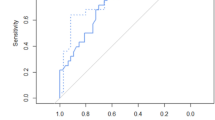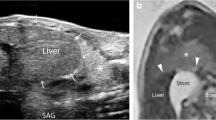Abstract
Objective
To assess whether the need for postnatal prosthetic patch repair of the diaphragmatic defect in neonates with a congenital diaphragmatic hernia (CDH) is associated with the antenatal measured observed-to-expected magnetic resonance fetal lung volume (o/e MR-FLV).
Methods
The o/e MR-FLV was calculated in 247 fetuses with isolated CDH. Logistic regression analysis was used to assess the prognostic value of the individual o/e MR-FLV for association with the need for postnatal patch repair.
Results
Seventy-seven percent (77 %) of patients with a CDH (190/247) required prosthetic patch repair and the defect was closed primarily in 23 % (57/247). Patients requiring a patch had a significantly lower o/e MR-FLV (27.7 ± 10.2 %) than patients with primary repair (40.8 ± 13.8 %, p < 0.001, AUC = 0.786). With an o/e MR-FLV of 20 %, 92 % of the patients required patch repair, compared to only 24 % with an o/e MR-FLV of 60 %. The need for a prosthetic patch was further influenced by the fetal liver position (herniation/no herniation) as determined by magnetic resonance imaging (MRI; p < 0.001). Fetal liver position, in addition to the o/e MR-FLV, improves prognostic accuracy (AUC = 0.827).
Conclusion
Logistic regression analysis based on the o/e MR-FLV is useful for prenatal estimation of the prosthetic patch requirement in patients with a CDH. In addition to the o/e MR-FLV, the position of the liver as determined by fetal MRI helps improve prognostic accuracy.
Key Points
• The o/e MR-FLV is associated with the need for postnatal patch repair in CDH.
• The need for a patch is associated with a significantly lower o/e MR-FLV (p < 0.001).
• The patch requirement is also influenced by fetal liver position.
• Fetal liver position, in addition to the o/e MR-FLV, improves prognostic accuracy.
• CDH-fetuses with a high probability for patch requirement can be identified prenatally.




Similar content being viewed by others
Abbreviations
- AUC:
-
area under the curve
- aMR-FLV:
-
absolute MR-FLV
- CDH:
-
congenital diaphragmatic hernia
- ECMO:
-
extracorporeal membrane oxygenation
- FLV:
-
fetal lung volume
- HASTE:
-
half-Fourier acquired single-shot turbo spin-echo
- LHR:
-
lung-to-head ratio
- o/e LHR:
-
observed-to-expected LHR
- o/e MR-FLV:
-
observed-to-expected MR-FLV
References
Ackerman KG, Pober BR (2007) Congenital diaphragmatic hernia and pulmonary hypoplasia: new insights from developmental biology and genetics. Am J Med Genet C: Semin Med Genet 145C:105–108
Lally KP, Lally PA, Lasky RE et al (2007) Defect size determines survival in infants with congenital diaphragmatic hernia. Pediatrics 120:e651–e657
Jani J, Cannie M, Sonigo P et al (2008) Value of prenatal magnetic resonance imaging in the prediction of postnatal outcome in fetuses with diaphragmatic hernia. Ultrasound Obstet Gynecol 32:793–799
Kilian AK, Schaible T, Hofmann V, Brade J, Neff KW, Busing KA (2009) Congenital diaphragmatic hernia: predictive value of MRI relative lung-to-head ratio compared with MRI fetal lung volume and sonographic lung-to-head ratio. AJR Am J Roentgenol 192:153–158
Jani JC, Peralta CF, Nicolaides KH (2012) Lung-to-head ratio: a need to unify the technique. Ultrasound Obstet Gynecol 39:2–6
Busing KA, Kilian AK, Schaible T, Debus A, Weiss C, Neff KW (2008) Reliability and validity of MR image lung volume measurement in fetuses with congenital diaphragmatic hernia and in vitro lung models. Radiology 246:553–561
Paek BW, Coakley FV, Lu Y et al (2001) Congenital diaphragmatic hernia: prenatal evaluation with MR lung volumetry–preliminary experience. Radiology 220:63–67
Ward VL, Nishino M, Hatabu H et al (2006) Fetal lung volume measurements: determination with MR imaging–effect of various factors. Radiology 240:187–193
Sola JE, Bronson SN, Cheung MC, Ordonez B, Neville HL, Koniaris LG (2010) Survival disparities in newborns with congenital diaphragmatic hernia: a national perspective. J Pediatr Surg 45:1336–1342
Waag KL, Loff S, Zahn K et al (2008) Congenital diaphragmatic hernia: a modern day approach. Semin Pediatr Surg 17:244–254
Romao RL, Nasr A, Chiu PP, Langer JC (2012) What is the best prosthetic material for patch repair of congenital diaphragmatic hernia? Comparison and meta-analysis of porcine small intestinal submucosa and polytetrafluoroethylene. J Pediatr Surg 47:1496–1500
de Buys Roessingh AS, Dinh-Xuan AT (2009) Congenital diaphragmatic hernia: current status and review of the literature. Eur J Pediatr 168:393–406
Chiu P, Hedrick HL (2008) Postnatal management and long-term outcome for survivors with congenital diaphragmatic hernia. Prenat Diagn 28:592–603
Jaillard SM, Pierrat V, Dubois A et al (2003) Outcome at 2 years of infants with congenital diaphragmatic hernia: a population-based study. Ann Thorac Surg 75:250–256
Gallot D, Boda C, Ughetto S et al (2007) Prenatal detection and outcome of congenital diaphragmatic hernia: a French registry-based study. Ultrasound Obstet Gynecol 29:276–283
Grushka JR, Laberge JM, Puligandla P, Skarsgard ED, Canadian Pediatric Surgery N (2009) Effect of hospital case volume on outcome in congenital diaphragmatic hernia: the experience of the Canadian Pediatric Surgery Network. J Pediatr Surg 44:873–876
Busing KA, Kilian AK, Schaible T, Dinter DJ, Neff KW (2008) MR lung volume in fetal congenital diaphragmatic hernia: logistic regression analysis–mortality and extracorporeal membrane oxygenation. Radiology 248:233–239
Busing KA, Kilian AK, Schaible T, Endler C, Schaffelder R, Neff KW (2008) MR relative fetal lung volume in congenital diaphragmatic hernia: survival and need for extracorporeal membrane oxygenation. Radiology 248:240–246
Debus A, Hagelstein C, Kilian AK, et al (2012) Fetal Lung Volume in Congenital Diaphragmatic Hernia: Association of Prenatal MR Imaging Findings with Postnatal Chronic Lung Disease. Radiology
Kilian AK, Busing KA, Schuetz EM, Schaible T, Neff KW (2009) Fetal MR lung volumetry in congenital diaphragmatic hernia (CDH): prediction of clinical outcome and the need for extracorporeal membrane oxygenation (ECMO). Klin Padiatr 221:295–301
Neff KW, Kilian AK, Schaible T, Schutz EM, Busing KA (2007) Prediction of mortality and need for neonatal extracorporeal membrane oxygenation in fetuses with congenital diaphragmatic hernia: logistic regression analysis based on MRI fetal lung volume measurements. AJR Am J Roentgenol 189:1307–1311
Rypens F, Metens T, Rocourt N et al (2001) Fetal lung volume: estimation at MR imaging-initial results. Radiology 219:236–241
Reiss I, Schaible T, van den Hout L et al (2010) Standardized postnatal management of infants with congenital diaphragmatic hernia in Europe: the CDH EURO Consortium consensus. Neonatology 98:354–364
Jobe AH, Bancalari E (2001) Bronchopulmonary dysplasia. Am J Respir Crit Care Med 163:1723–1729
Brindle ME, Brar M, Skarsgard ED (2011) Patch repair is an independent predictor of morbidity and mortality in congenital diaphragmatic hernia. Pediatr Surg Int 27:969–974
Jani JC, Benachi A, Nicolaides KH et al (2009) Prenatal prediction of neonatal morbidity in survivors with congenital diaphragmatic hernia: a multicenter study. Ultrasound Obstet Gynecol Off J Int Soc Ultrasound Obstet Gynecol 33:64–69
Loff S, Wirth H, Jester I et al (2005) Implantation of a cone-shaped double-fixed patch increases abdominal space and prevents recurrence of large defects in congenital diaphragmatic hernia. J Pediatr Surg 40:1701–1705
Tsao K, Lally KP (2011) Surgical management of the newborn with congenital diaphragmatic hernia. Fetal Diagn Ther 29:46–54
Jawaid WB, Qasem E, Jones MO, Shaw NJ, Losty PD (2013) Outcomes following prosthetic patch repair in newborns with congenital diaphragmatic hernia. Br J Surg 100:1833–1837
Tsai J, Sulkowski J, Adzick NS, Hedrick HL, Flake AW (2012) Patch repair for congenital diaphragmatic hernia: is it really a problem? J Pediatr Surg 47:637–641
Ruano R, Lazar DA, Cass DL et al (2014) Fetal lung volume and quantification of liver herniation by magnetic resonance imaging in isolated congenital diaphragmatic hernia. Ultrasound Obstet Gynecol 43:662–669
Wright T, Filbrun A, Bryner B, Mychaliska G (2014) Predictors of early lung function in patients with congenital diaphragmatic hernia. J Pediatr Surg 49:882–885
Valfre L, Braguglia A, Conforti A et al (2011) Long term follow-up in high-risk congenital diaphragmatic hernia survivors: patching the diaphragm affects the outcome. J Pediatr Surg 46:52–56
St Peter SD, Valusek PA, Tsao K, Holcomb GW 3rd, Ostlie DJ, Snyder CL (2007) Abdominal complications related to type of repair for congenital diaphragmatic hernia. J Surg Res 140:234–236
Ba'ath ME, Jesudason EC, Losty PD (2007) How useful is the lung-to-head ratio in predicting outcome in the fetus with congenital diaphragmatic hernia? A systematic review and meta-analysis. Ultrasound Obstet Gynecol 30:897–906
Jani J, Nicolaides KH, Keller RL et al (2007) Observed to expected lung area to head circumference ratio in the prediction of survival in fetuses with isolated diaphragmatic hernia. Ultrasound Obstet Gynecol 30:67–71
Acknowledgments
The scientific guarantor of this publication is Prof. Dr. K. Wolfgang Neff. The authors of this manuscript declare no relationships with any companies whose products or services may be related to the subject matter of the article. The authors state that this work has not received any funding. One of the authors has significant statistical expertise: (Dr. Christel Weiß, Department of Medical Statistics and Biomathematics, University Medical Center Mannheim, University of Heidelberg, Germany). Institutional Review Board approval was obtained. Written informed consent was obtained from all subjects (patients) in this study. Some study subjects or cohorts have been previously reported in studies of our study group. None of the previously published studies put focus on the need for prosthetic patch repair as a clinical endpoint. Methodology: retrospective, diagnostic or prognostic study, performed at one institution.
Author information
Authors and Affiliations
Corresponding author
Rights and permissions
About this article
Cite this article
Hagelstein, C., Zahn, K., Weidner, M. et al. Prenatal MR imaging of congenital diaphragmatic hernias: association of MR fetal lung volume with the need for postnatal prosthetic patch repair. Eur Radiol 25, 258–266 (2015). https://doi.org/10.1007/s00330-014-3410-8
Received:
Revised:
Accepted:
Published:
Issue Date:
DOI: https://doi.org/10.1007/s00330-014-3410-8




